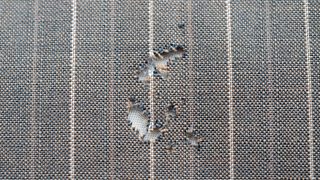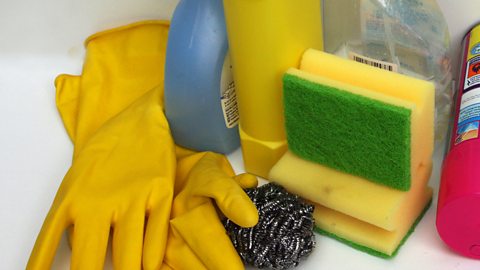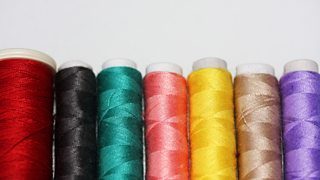How to avoid “Mothmaggedon”
Clothes moths – the little winged critters that enjoy making a meal of your jumpers and carpets – are on the rise. Recently, English Heritage found that infestation levels were “alarmingly high” in Southern England. And, as anyone who has found them fluttering through their wardrobe will affirm, they can be very difficult to get rid of.
Presenter Felicity Evans, who is waging a one-woman war against the moths living under her floorboards, has tried just about every repellent on the market. She sets out to answer one question: is there any sure way to prevent “Mothmageddon”?

-
![]()
Mothmageddon
Presenter Felicity Evans tells the story of her one-woman battle with textile moths.
What are the little creatures making holes in your favourite jumpers?
There are about 20 species of clothes moths and none of them actually eat our clothes – their larvae do.

These little grubs feed exclusively on animal fibres – like wool, fur, silk, and feathers – because they all contain a protein called keratin.
Hard as it might be to believe, these moths haven’t actually evolved to eat our clothes.
In the wild they would live on animals or in birds’ nests, feeding on the feathers or fur that the birds collect to build their homes. They just happen to have come across a niche – human clothing – and have exploited it for all it's worth.

How big is the problem?
Under the microscope, clothes moths are beautiful creatures: silvery gold in colour with a tuft of orange hair on their heads. But though they might look innocent, moths are becoming an increasing problem – these voracious pests continue to gain ground around the country. A recent study by revealed a 216% increase over five years in the number of common clothes moths caught in its traps.
So, what can be done be done about it?
One or two moths can very quickly become an infestation – these creatures are tenacious. There are, however, steps you can take to eradicate moths.
-
Vacuum
Moth larvae can feast on organic dust so housekeeping is a really good way of keeping pest numbers down. Hoover your carpets and dust your surfaces.
-
Iron and steam clothes
Washing and drying clothes won’t reliably kill moth eggs, but moth larvae and eggs can be quickly killed with a high heat. They might still be lurking in your carpets but they won’t survive on any clothes that are thoroughly ironed or steamed.

Aggie from How Clean Is Your House gives top tips
Aggie MacKenzie talks to Louise Minchin about the best cleaning habits.
-
Fill your draws with cedar and lavender
Moths don’t like the smell of cedar or lavender so fill your draws and wardrobes with cedar wood balls and bags of dried lavender flowers.

-
Store clothes in airtight containers
Try not to leave any materials like wool exposed to the air. Keep them in zipped, airtight bags inside sealed containers to prevent the moths getting to them. During the summer, get all those woollens packed safely away!
-
Freeze your clothes
A sure-fire way to kill moth larvae is to freeze them. Keep any clothes item in the freezer for at least 24 hours to make sure any larvae are killed off. (And put them in a plastic bag first!)
-
Use pheromone traps
Pheromone traps work by mimicking the female moth sex hormone. Male moths are attracted to a chalky tablet which then covers them in the hormone. Other male moths then try to mate with them, picking up the scent themselves, further spreading the confusion. This can decrease successful mating activity and, over time, really help to decrease a population.
Anyone with an infestation will know that the fight against moths can be slow, lengthy and demoralising. But your persistence will pay off.
Alternatively, sticky pads impregnated with the moth pheromones will lure male moths to a sticky demise. And although the female moths will still be roaming free, it does make it harder for them to reproduce and spread their eggs.
-
Brute force
Of course, you can always swat them when you spot them. Although you will be left with a literal reminder of your cruelty in the form of squashed moth corpses on the walls.
-
Call in a pest controller
If things get really dire, call in the professionals. Pest controllers can spray insecticide into problem areas. In Felicity’s case, they drilled holes in her floorboards and pumped the chemicals under her floors.
So, can you ever get rid of moths completely?
Anyone with an infestation will know that the fight against moths can be slow, lengthy and demoralising.
Felicity’s pest controller Phil states how it can be a losing battle even for the pros: “We always aim to complete elimination but sometimes that’s never going to be achieved, even with the most thorough treatment programmes.”
The answer then? As well as taking all the measures above, swap your carpets for lino, try and source more clothing that isn’t a moth’s idea of heaven, and keep methodical and persistent in your approach. Without food, with any luck, the moths will be off.
Won’t they?
Listen to Felicity Evans as she tells the story of her battle with moths.

Why do we buy clothes that we never wear?
There is more than three billion pounds' worth of unworn clothes in the UK's wardrobes.
More from Radio 4
-
![]()
Mothmageddon
Presenter Felicity Evans tells the story of her one-woman battle with textile moths.
-
![]()
Natural Histories: Moth
Brett Westwood steps into the world of a creature charged with the lore of the night.
-
![]()
10 fashion ideas that will help save the planet
For the fashion-loving consumer who wants to go green, here are ten trends and tips.
-
![]()
9 ways to stay stylish without spending a fortune
These 9 thrifty tips will help you dress like a style icon without it costing a thing.




